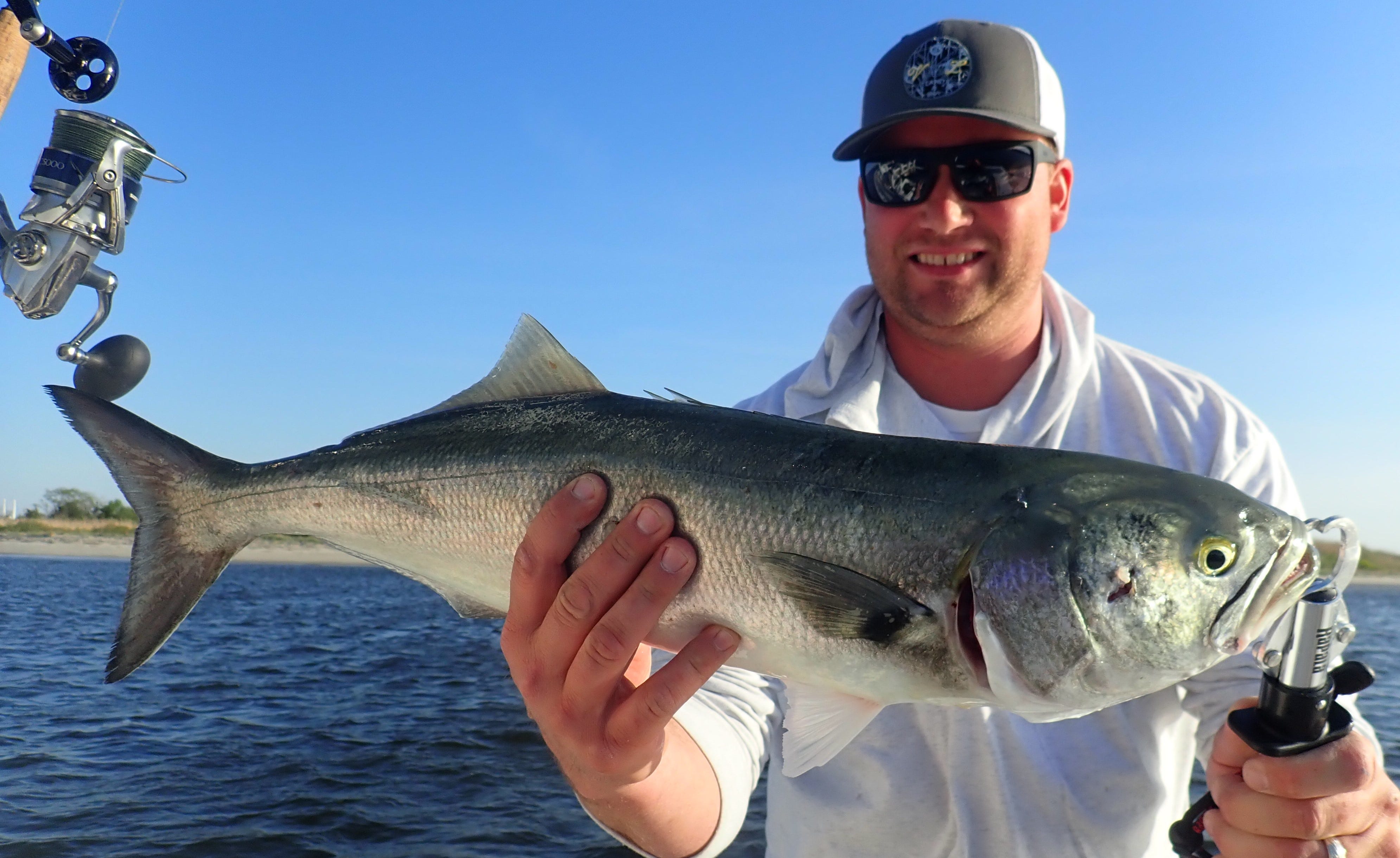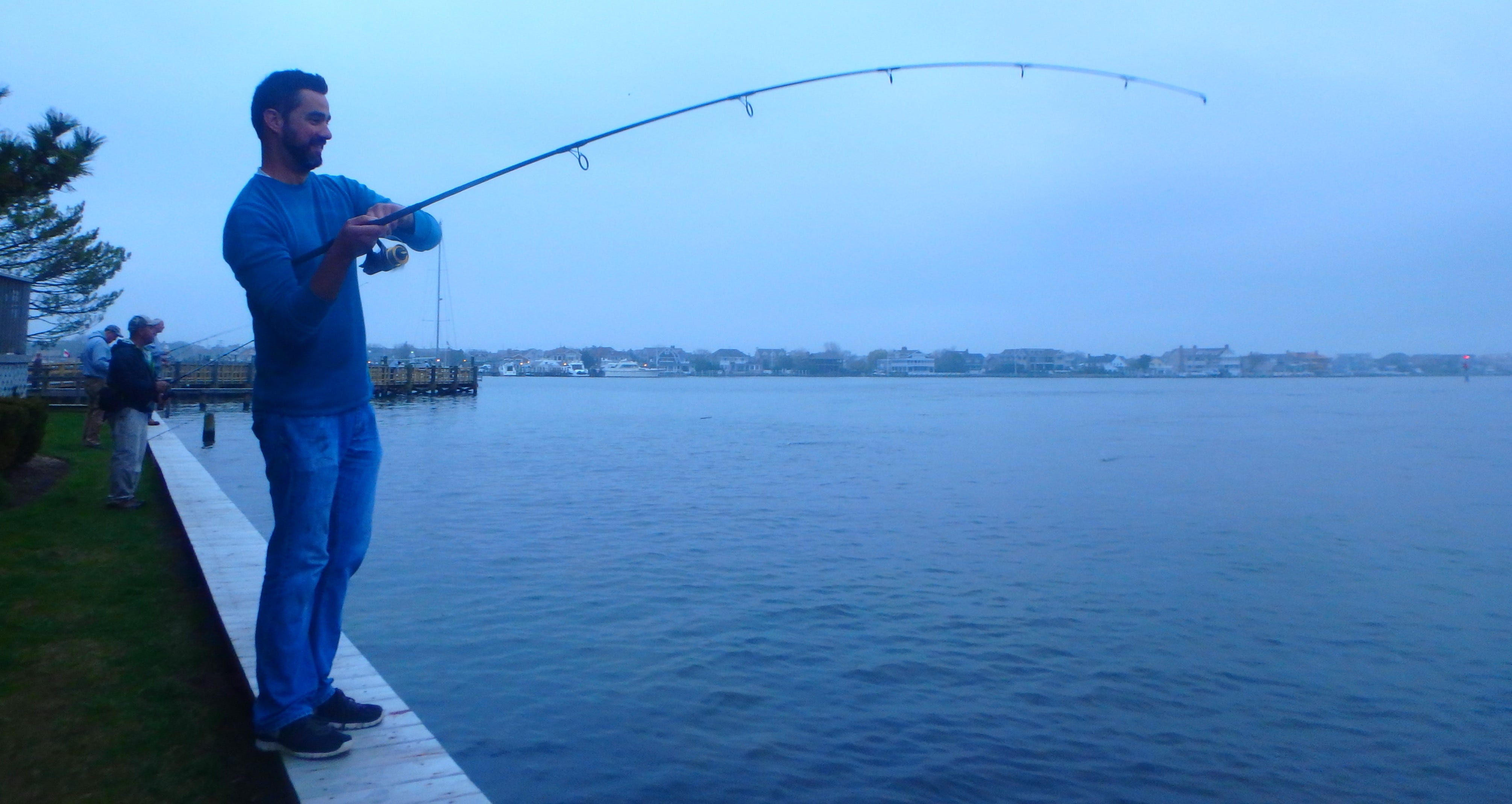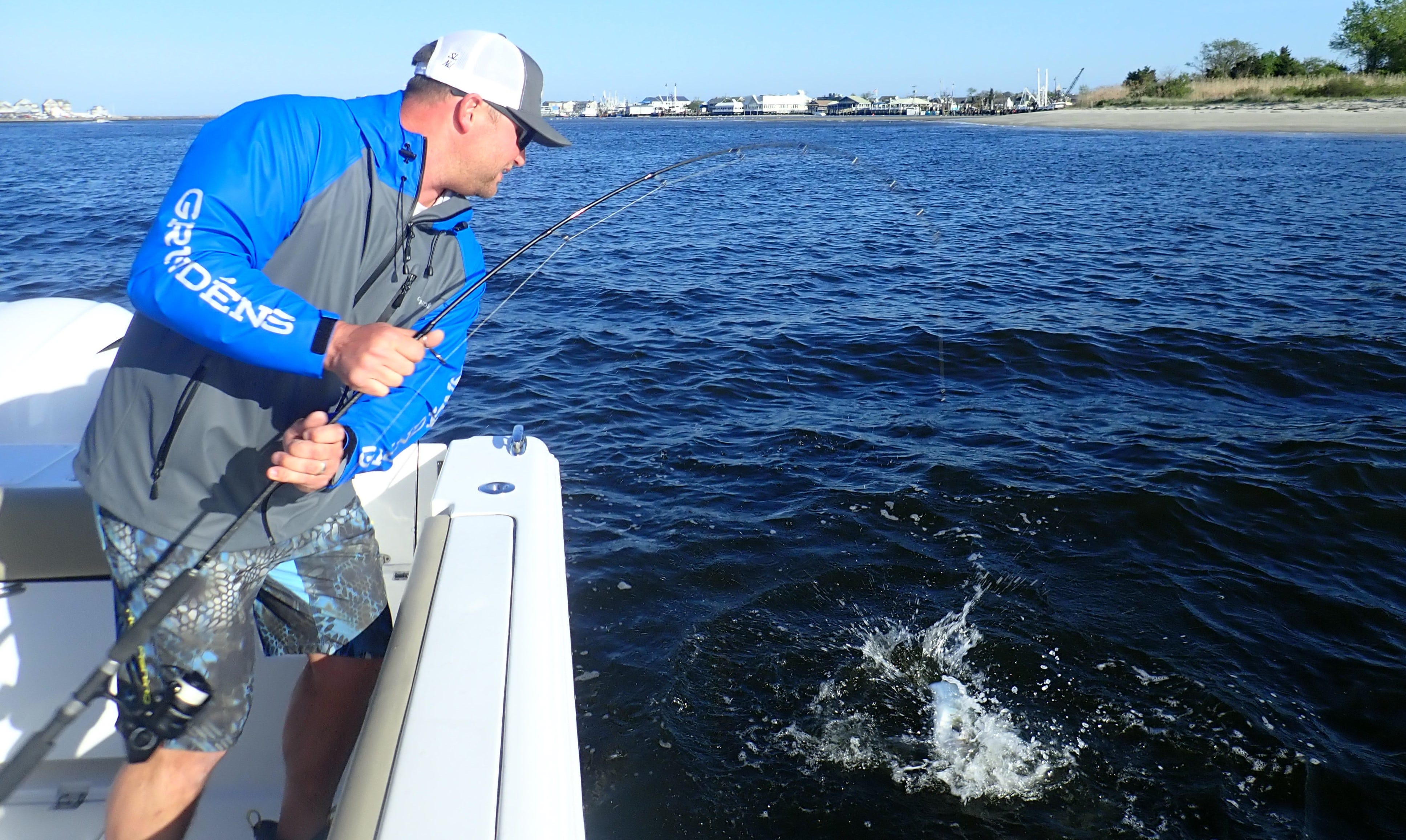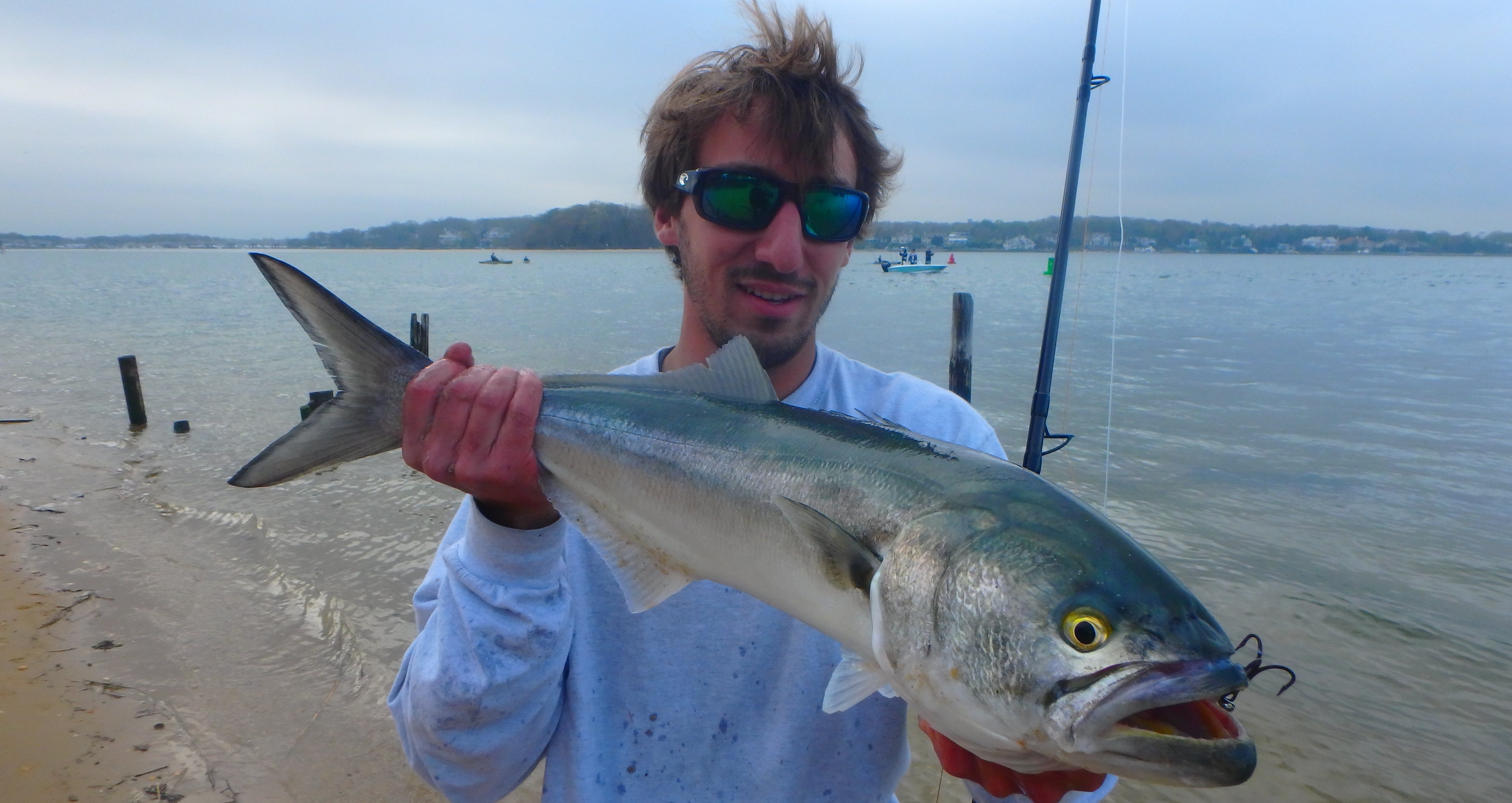- Aug 19, 2021
Use Poppers to Catch More Summer Bluefish
Brutally strong fish and vicious topwater strikes make a fabulous combination. Here’s what you need to know to get in on exciting bluefish action this summer.
Pound for pound, bluefish are known as the hardest fighting inshore fish along the Northeast coast. Blues demand respect, punishing rods, destroying lures with knife-bladed teeth, ripping drags, and blowing up reels with powerful runs.
Ask other anglers: Topwater popping for any gamefish typically tops the list of exciting ways to fish. When you get topwater blow-ups from 10-, 15- and even 20-pound alligator bluefish, the adrenaline meter goes through the roof.
Spring, Summer & Fall


Along the Jersey Coast and most of the Northeast, bluefish can be caught during the spring, summer and fall months. They migrate northward up the East Coast during spring and back down the coast, come fall.
Spring-run bluefish put on the feedbags to fatten up as they have been conserving energy during the leaner winter months. Spring blues cruise along the shore and will begin to enter the back bay systems in pursuit of a meal.
Blues will be found in the bay systems throughout the summer, but they also patrol the surf line and travel nearshore from 1 to 15 miles off in search of food.
During autumn, as baitfish such as mullet, bunker, spearing and rainfish spill out of the backwaters to migrate south, blues get on their tails and can be easily caught surfside.
Bluefish abound in a wide range of sizes and corresponding nomenclature: generally called snappers when less than 1/2 pound; cocktails from 2 to 3 pounds; choppers from 4 to 10 pounds; gators from 10 to 18 pounds; and gorillas from 18 to 24 pounds. Bluefish of all sizes will aggressively attack a topwater popper offering as the commotion triggers the mean and nasty disposition of a bluefish to eat whatever seems like easy, fleeing prey.
Gearing for Blues


With bluefish, you’re going to lose gear. A lot of it. You need rods, reels and gear with a lot of brawn to effectively manage and battle a big blue on the line.
From the boat or bankside of a river, a beefy 7-foot spinning rod rated for 20- to 50-pound test, matched with a 6500-class reel and spooled with 50-pound braided line makes a good set-up. For fishing the surf, switch to a 9- to 11-foot spinning rod, rated for 30- to 50-pound line, medium to fast action, matched with a 7500-class reel.
From the braided line, attach a 100-pound Spro barrel swivel to a 36-inch section of 50- to 60-pound monofilament leader, with a 100-pound TA Clip on the end to switch out lures. Or tie on a 12-inch 80-pound class steel leader with snap clip. The long mono leader is key to landing fish and avoiding the dangers of big-mawed snapping jaws, as you can grab the leader and either swing it over the boatside or drag it up onto the bank without cutting through your hands like braided line can.
Now for the poppers. Tried and true poppers include the Creek Chub Knuckle-Head, Rebel Super Pop-R, and Cotton Cordell Pencil Popper. All have their applications, but heed one word of advice: With any popper, switch out all treble hooks for a lone single hook. Bluefish are notorious for slashing and crashing around to sink a flying hook into your flesh. Single hooks dramatically reduce that possibility.
- Creek Chub Knuckle-Head – The namesake knuckle or joint makes this bulky popper extra erratic to suggest an injured baitfish and prompts vicious strikes.
- Cotton Cordell Pencil Popper – This classic popper walks and pops, creating a big disturbance and allowing fish to home in on a target. Available in three sizes. Excellent in the surf.
- Super Pop-R – With its smaller profile the Super Pop-R is outstanding when slick conditions or high pressure make the fish more finicky and for mimicking small forage.
Bay Fishing


The Creek Chub Knuckle-Head popper is a prized offering for bay anglers. The cocked-head design shoots wild spray, and inner rattling shots beckon blues to come investigate in the still bay waters.
Bluefish invade the bay systems and are easily found by the crashing and splashing of the water surface as they pummel bait schools. Look for signs of birds dipping down into the water to pick off the bait as blues push them to the surface. Cast poppers to the outskirts of the school and start a rip/pop-pause-rip/pop type of retrieve so the popper pushes a spray of water and then pauses.
Most times blues will hit when the popper is paused, but stay ready, as gators will also aggressively attack and chase the popper when it is being pulled, sometimes stunning the angler.
Poppers like the Rebel Pop-R also work magic when cast along a sodbank, off a dock piling or around a bridge abutment as the surface commotion alerts fish below that a “baitfish” is fleeing the protection of the structure and will make an easy meal.
- Cast around structures and to edges of schools of visually feeding fish.
- Impart a pop-pause-pop retrieve.
- Stay on the lookout for diving and circling birds, which reveal where bluefish are pushing baitfish to the surface.
The Surf Approach


One of the greatest joys of fishing is catching monster gamefish with your feet planted in the surf sand. Surf fishing for blues starts in spring as skinnier 4- to 10-pound fish move in, replaced by 2- to 4-pound fish in the summertime, then edged out by gators of 10- to 18-pounds during the fall run.
Summertime bait schools include peanut bunker, spearing and rainfish, so smaller type poppers of 3 to 5 inches will work best then. During spring and fall, adult bunker, herring and mackerel are primary baits around so larger model poppers of 6 to 10 inches work best then.
Sunrise hours are famously prime time to find blues feeding as they hound-dog bait schools right into the undertow. That said, during summer months, blues will feed in the surf throughout the day.
The Cotton Cordell Pencil Popper is in its glory in the surf as the lagging butt of the popper sits in the water while the head of the popper swings side to side, creating commotion.



